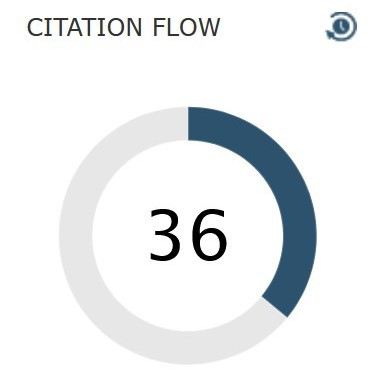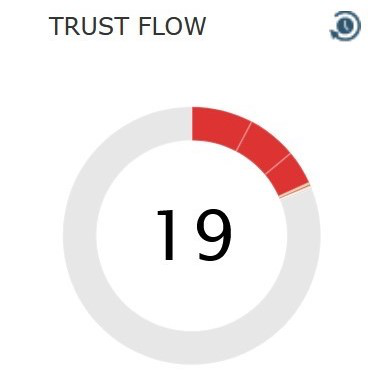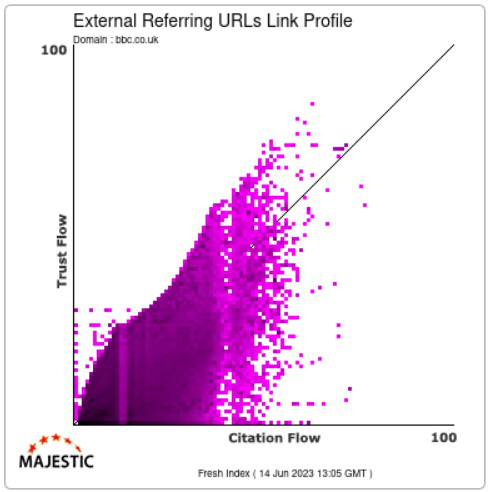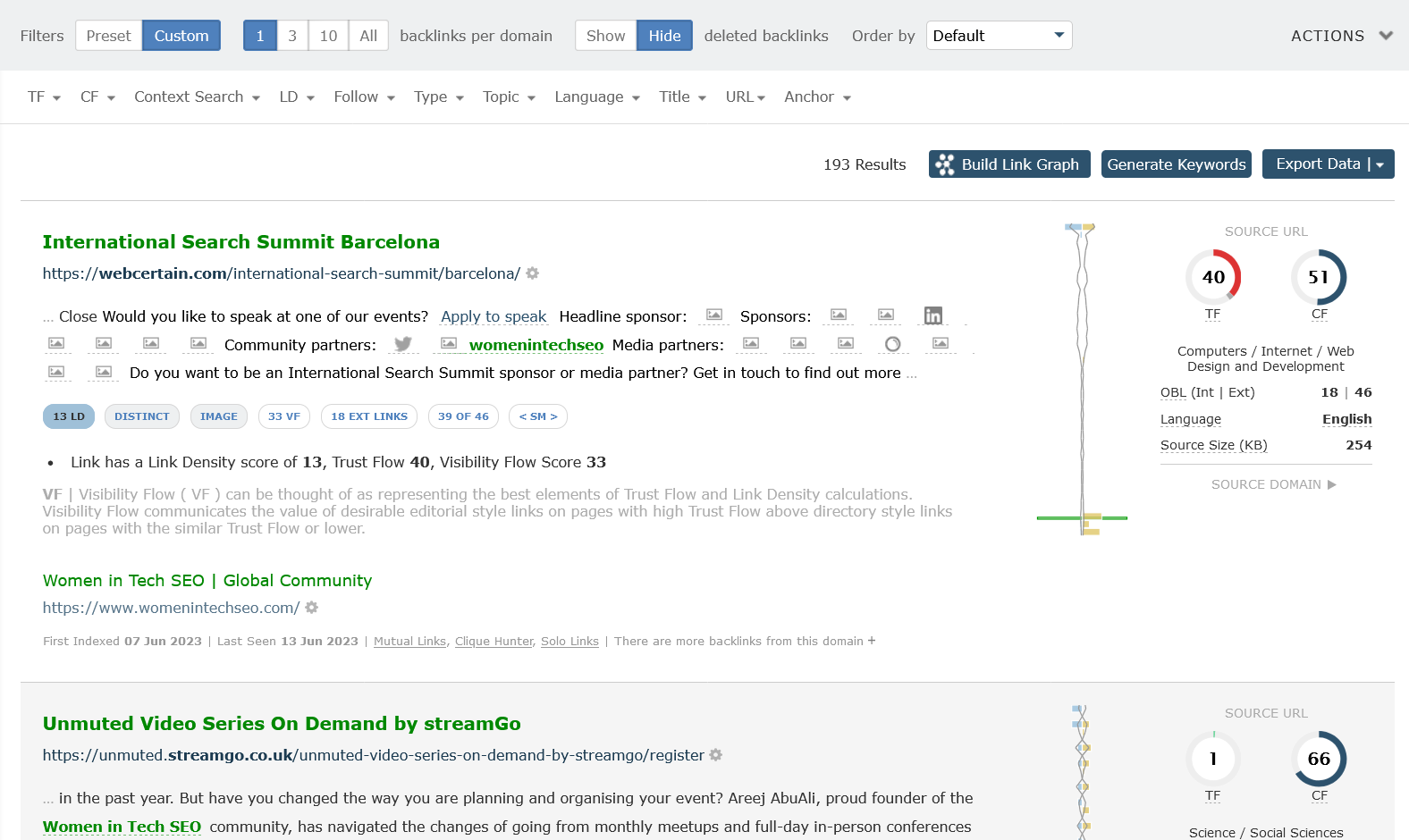Flow Metric Scores
Majestic offer a number of ranking scores derived from analysis of its web map. These are:
- Citation Flow
- Trust Flow
- Topical Trust Flow
- Visibility Flow
- Search Flow
The algorithms which produce these scores are based on years of research on the science of search. This has resulted in ranking signals which could, in theory, be used in the creation a full text search index.
The most well-known of these scores are Citation Flow and Trust Flow. Flow Metric scores are intended for use in like for like comparisons, for example, using Trust Flow to compare homepages of different sites. It is not advisable to compare Trust Flow of a web page against the Trust Flow of a website.
The processes which produce Flow Metric scores are often revisited and refined. This evolution of the underlying algorithms can produce fluctuations in the resulting scores. If you make use of services which track Flow Metric scores over time, we suggest that looking at long term trends may be more useful.
Some people ask why so many scores? The answer is simple. Each score represents a different measure of the impact of your content on the web. SEOs and digital marketers can gain great insight from investigating where the balance between Flow Metric scores differ from the norm.
Citation Flow
Citation Flow is a score which reflects the quantity of links that point to any given website. Citation Flow does not care whether a link is of good-quality, or poor quality. Majestic produce Citation Flow scores at URL, subdomain and domain level.

You may have heard that experts from Google like John Mueller have stated that raw counts of backlinks aren't particularly useful as a ranking signal. Citation Flow goes beyond raw backlink counts to look at the wider link network, such as the sites linking into the sites that link to you and the sites that link to them and so on…
The advanced network maths that power Citation Flow scores produces a far more robust analysis than backlink counts alone. However, for the best analysis, additional data points are needed. Read on to see how Trust Flow compliments Citation Flow for backlink prospecting and backlink audit and analysis.
What is a good Citation Flow score?
Citation Flow scores are best used as a relative measure against competitors. A Citation Flow of 15 may be good for a local café or restaurant, but poor for a social media platform seeking worldwide dominance.
At Majestic, we believe you should not rely on just one metric, but instead use a variety of data points when evaluating Web Pages and Web Sites against each other.
Citation Flow is often used in conjunction with Trust Flow. If links have only been gained from quality sites, then one might assume the resulting Trust Flow and Citation Flow scores would be similar.
Because of the noisy background, it is very rare for a website to have a larger Trust Flow than Citation Flow. A few exceptions exist including mit.edu, the website for the Massachusetts Institute of Technology which has a Trust Flow of 93 and a Citation Flow of 71 (at June 2023). Likewise, Stanford has a Trust Flow of 93 and Citation Flow of 73.
Trust Flow
Trust Flow is arguably the most popular Flow Metric score.

Spam - low grade machine generated content - is an issue on the web. Search engines have developed a number of ways of attempting to identify spam so that it can be removed, or at least deprecated, from search results.
Trust Flow represents our attempt to produce a ranking signal that promotes quality content. These algorithms work on the basis that websites from a seed set of human-curated sites are likely to link to other human-curated quality content (which in turn link to more human-curated content). Trust Flow scores are the result of modelling this process on the Majestic web map, ranking and rating billions of points of data.
Trust Flow is used in conjunction with Citation Flow for Toxic Link Analysis and Penalty Remediation. The difference between Trust Flow and Citation Flow scores for any given web page can be an important signal in its own right.
Visualising Citation Flow and Trust Flow with the Link Profile Graph
The Link Profile Graph goes beyond the headline Citation Flow and Trust Flow scores. Link Profile visualises the Citation Flow and Trust Flow of all of the inbound links to a page or website.

The Link Profile Graph is a 3D scatter plot. The Trust Flow and Citation Flow of each backlink is considered. If a backlink has TF 75 and CF 70, for example it would be plotted about 70 dots along and 75 dots up. If another backlink happens to have the same TF and CF then we can’t redraw the same square, so we make it darker. Thus darker regions of the Link Profile Graph have more backlinks with the ratio indicated. This is why we describe the graph as 3 dimensional. The X-axis represents Citation Flow, the Y-axis represents Trust Flow and the depth of colour reflect the number of links with that Citation Flow / Trust Flow combination.
The Link Profile graph can be helpful in comparing a site against it’s competitors. The Link Profile chart might illustrate that one site has a higher quantity of low Trust Flow backlinks than another, or that a high Trust Flow score may depend on a relatively small number of extremely high quality links. Either insight could help inform the construction of a bespoke content and outreach strategy.
Topical Trust Flow
The processes that result in the Topical Trust Flow Score represent a significant leap of complexity over the system used to calculate Trust Flow.
Rather than consider the seed sets as a pool, the algorithms behind Topical Trust Flow are based on a far more granular representation of the seed set. Over 800 pools of sites have been identified and classified, and the algorithm follows outbound links from these pages, passing along not only a strength signal but also classification by topic.

While not a "Silver Bullet", quality links from relevant websites are thought to be a significant ranking factor in full text search engines. Topical Trust Flow can help illustrate the importance of relevancy to clients of SEO services. Topical Trust Flow scores are reported at URL, subdomain and domain level.
Visibility Flow
Visibility Flow is the newest score in the Flow Metric family. Visibility Flow is available within the Link Context report in Majestic Site Explorer


Unlike Citation Flow and Trust Flow, Visibility Flow is a link level score. The algorithms behind Visibility Flow attempt to prioritise high quality editorial links over easier to gain directory-style links.
The processes behind Visibility Flow are under active development, potentially making it one of the more volatile Flow Metric scores.
What's wrong with Referring Domain or Backlink Counts?
If all of the math that is used to calculate Flow Metric scores sounds complex, you may wonder why simpler measures of website popularity are not used instead.
In the early days of SEO, independent, quality metrics were hard to come by. An early attempt at assessing website popularity was to count the number of inbound links, or number of domains which linked in to a web page.
The difficulty with inbound link counts (also known as backlink counts) is two fold:
- It is incredibly easy to manipulate backlink counts. A website can contain hundreds, if not thousands or millions of different web pages. If each of these many pages links to the same place, the result is potentially an equal number of backlinks. While backlink counts can be adjusted to mitigate, trying to decide which ones to keep and which ones to drop is a complicated process.
- Raw backlink counts only measure the quantity of immediate neighbours. On the web, not all links are equal. A high quality link which links to another site which then links to you may have far more value than 100 low quality links from sites no one sees.
Referring Domain counts could be thought of as better than backlink counts, but the figure is still open to manipulation.
Read More: the challenges of comparing Referring Domain and Backlink counts between different backlink providers has been discussed on our blog.
How do you check Flow Metric scores?
Flow Metric scores are available:
- Via our Software as a Service platform at Majestic.com,
- For API as documented on developer-support.majestic.com,
- Downloadable software including the Majestic Browser Plugins
There are two additional methods of accessing Majestic Flow Metric scores.
Majestic OpenApps
OpenApps connects your Majestic account to third party software and services. This delivers you Link Intelligence data direct into your favourite software. Downloadable applications like Screaming Frog or other online services make accessing Flow Metric scores easy.
Resellers
Majestic has licenced a small number of authorised resellers to make Flow Metric scores available via service, downloadable software and consulting services.
You can learn more about Majestic data partners on the Majestic blog.
How to improve your Flow Metric scores
As Majestic Flow Metric scores do not directly influence search engines, there is little to be gained in and of its self by seeking to enhance your Trust Flow or Citation Flow.
People who ask how to boost their Trust Flow often want to increase the popularity of their website so that it ranks higher in search engines, and/or can command a higher price at auction.
Fundamentally, this form of SEO activity seeks to enhance your site's authority online. Site authority can be enhanced by producing good quality content, and using effective digital PR in order to ensure your content is seen and evaluated by influential figures.
Good, White Hat, SEO should result in an increase in your websites authority, and as a consequence, your Flow Metric scores. Any increase in the value of scores should be seen as a celebration of your success, rather than the cause of it.
Learn more about Flow Metric scores
Learn more about Majestic & SEO:
Could we improve this page for you? Please tell us